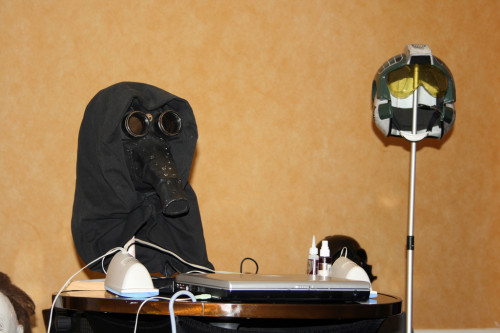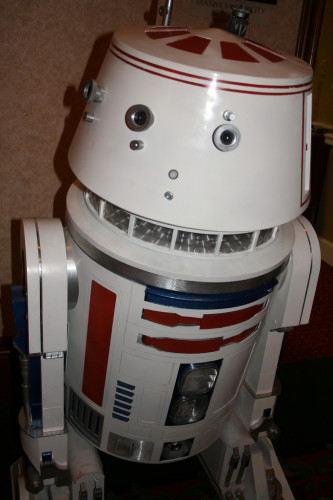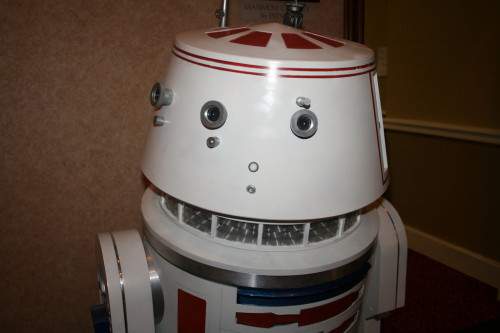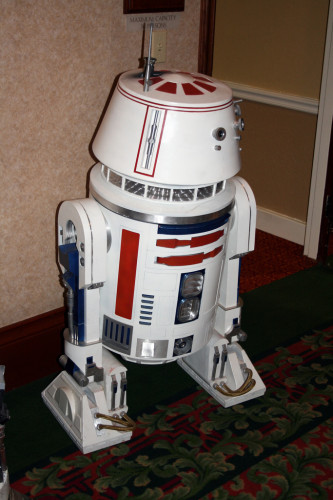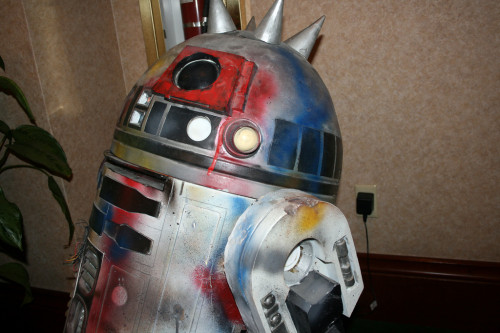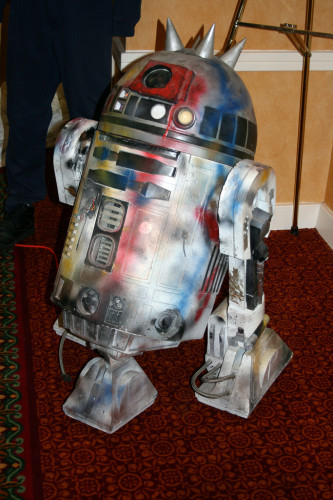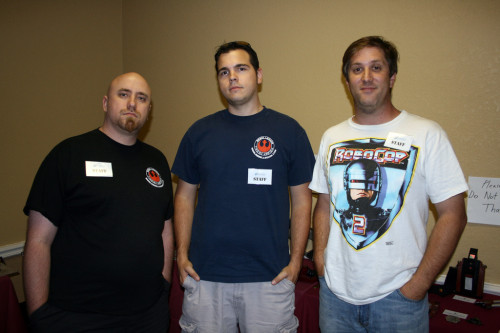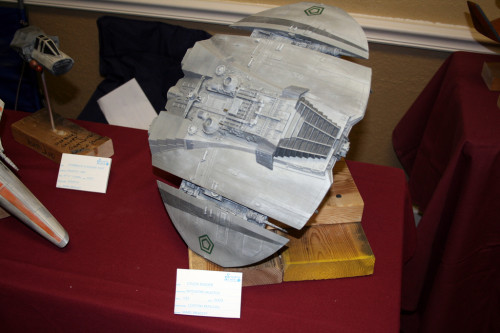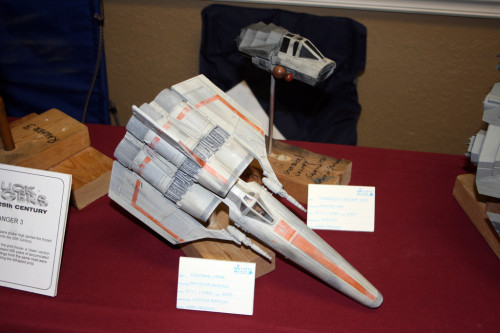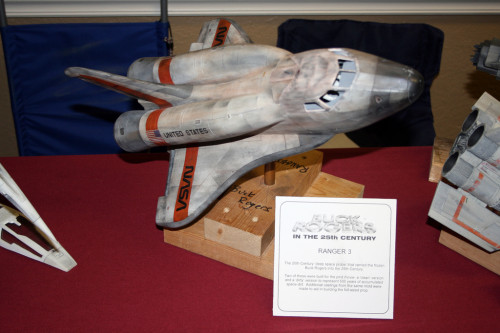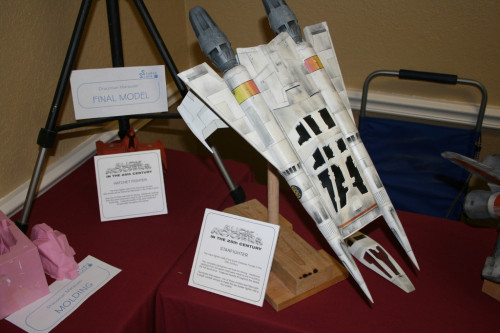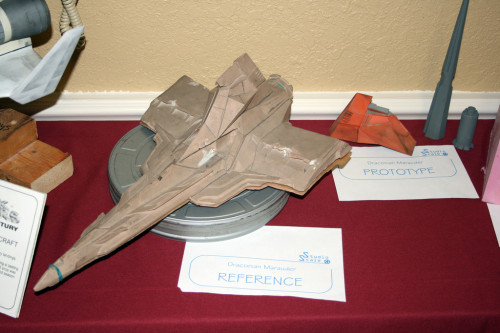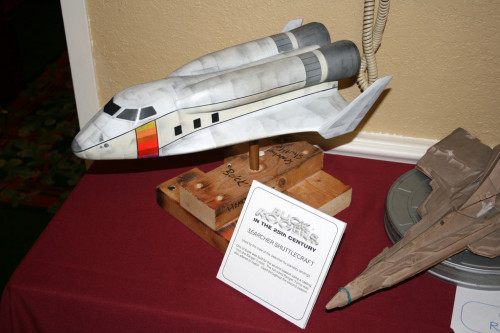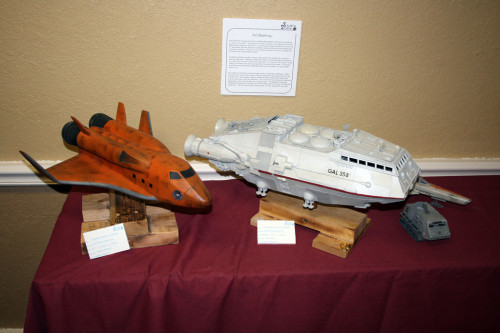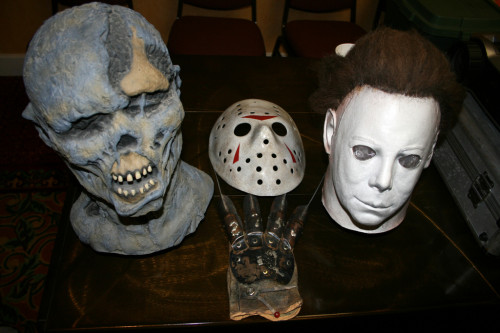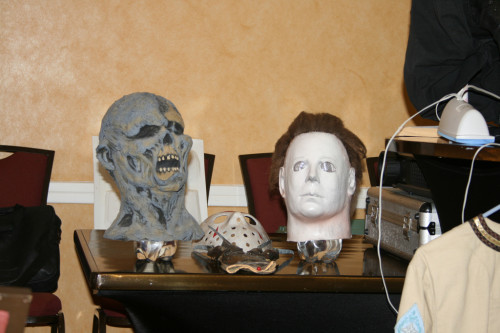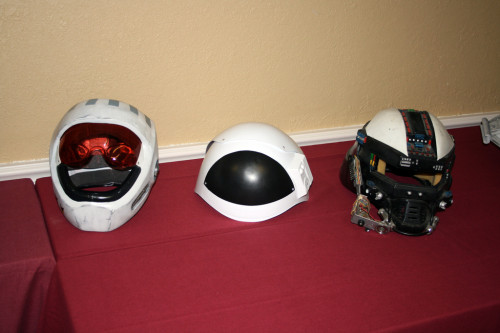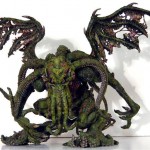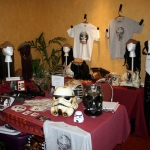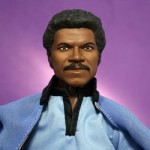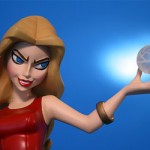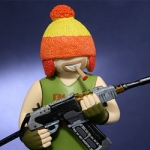One of the discussion panels I attended at Vulkon in Orlando last weekend was about prop building and making sci fi costumes. The three guys who led the panel, Mark Bradley, Eric Kumor, and Ken Ograyensek, are experts when it comes to molding, casting, shaping, and assembling the various bits and pieces that come together to form everything from Boba Fett armor to Jason Voorhees masks to intricate spaceship models. After the panel, I caught up with them in Vulkon’s prop room, where I was able to talk with them for about half an hour.
Mechazilla: I was able to see your presentation earlier, and it was very cool to see all the props you guys make. First, I was wondering if you could tell me how you got started doing this.
Mark: Well, just growing up with Star Wars and Star Trek. I’d always had hobbies like model building and things like that. I didn’t really get into the whole prop and costume thing until the late 80s. I guess when you’re little you don’t really think about wearing a costume, because that’s more of a full size thing. The first prop I ever made was when I was trying to make a phaser out of the old Franz Joseph technical manual. I carved it out of balsa wood and played around with that kind of thing. I’ve always been compelled to build things, and then it was just a natural outgrowth to do all the other things with costumes and whatever else. It was a hobby first, and I ended up doing it more or less as a living later on. I just kind of fell into it.
Eric: I had kind of the same thing. Growing up as a kid I was always fascinated by sci-fi and Star Wars and then more into horror. My parents were good parents. They let me watch scary bloody movies when I was four or five years old. So I developed a taste for that and for special effects. I wouldn’t watch it so much for the movie as I would as a class teaching me, “Hey, how can I learn how to do this? How can I do that?” I’d get ketchup bottles and bust into mom’s makeup and grab any piece of cardboard, tin foil, or anything I could find and piece it together and make something to gross somebody out. I always had fun with that. From there it evolved, and I learned the right way to do everything. The actual first movie prop I ever made was a Darth Vader lightsaber from Return of the Jedi. I made that when I was in high school. I found half of a Graflex-
Mark: A Halflex?
Eric: Yeah, half of a Graflex. I took epoxy putty and made all the little greeblie parts for it just based off pictures that I took from Magic and Myth when it was in DC. So I built it up from there, and it was my first one.
Ken: I think I was of the horror bent to begin with, too. Late middle school, early high school, that’s what I wanted to do. I wanted to make blood fly across the room.
Mechazilla: I guess it’s good you ended up with prop making instead of something else!
Ken: [laughs] Yeah, one Halloween in high school, I went and had a fake eyeball hanging down bouncing against my cheek all day long in school. I gave myself a horrible headache because I had the one eye covered. And then I moved out of it. I was in the service for a while. I was always a roleplaying geek, not like overly a LARPing thing, but I got online because I was away from my group, and I got into Star Wars roleplaying. It was on a forum, and people started saying, “Hey, have you seen the pictures of this guy? He’s got a full X-Wing gear.” And I was like, “Really? I want a full X-Wing gear! I have no idea what I’m gonna do with it, but I want some.” And that’s where it started. And then those talks eventually rolled into the Rebel Legion, so it just snowballed from there.
Mark: I think the genesis of this stuff is always… Obviously it comes from watching the movies or the TV shows, but I guess the creative impulse makes you want more. You want to be a part of that. You want to play in that universe. So a prop or something that is full sized and real makes you feel like you’re there. Once you hold something you saw in that movie, there’s a little bit of magic to it. And typically learning all these things is a means to an end. You’ll learn the skills and have fun doing it, but in the end you have that thing. You have that thing you saw. You become a part of it in some way.
Eric: And the more you build and the more techniques you learn, the more contacts you make for all the different avenues of props and movie collecting. It helps bring out more of that creative side to you. It’s like, if you see a new movie in the theater you can say, “Hey, I bet I could figure out how to make that in a weekend in my garage.” And you can do it.
Mechazilla: If there’s someone who has zero craftsmanship experience and zero knowledge about putting this stuff together but they want to have a costume to wear to a convention, where would you guys suggest that they start with getting into this sort of thing?
Eric: Research, research, research. The Internet is a fantastic tool. There are many different fan groups and websites out there now that specifically deal with costume pieces. And if you don’t have the talent or the desire to make it yourself, there are other people out there that can and will make it. It’s just a matter of meeting people, being accepted into the groups, and finding the contacts, and then everything falls into place from there. It’s grown into more of a networking between yourself and everybody else.
Mark: And the networking becomes resources for finding these things. If you’re talking about costumes or even props, a lot of it is made up of many different elements, and it required many different types of skills. You may have one or two of those skills, but you don’t have the others. These groups fill that in. They network you with other people, and those people become a resource to you, and if you can do any of these elements, you become a resource to them.
Eric: That’s where the trading system comes into play. Generally if you make stuff for sale or whatnot, you charge enough to cover your time and your material costs, but if you’re bartering and trading, a lot of people will trade you one for one. You can come away with an entire costume, having not spent anything other than your own material costs for parts to trade away.
Mark: Absolutely. And on the things you can’t find a resource for, in the area of giving advice, I’d say if you can’t find anybody else like that, do try to do it yourself. Just try it. You’ll usually surprise yourself by being able to do things that you didn’t think you could do when you have your eye on the ball. When you have the vision of what you want to have when you’re done, you find ways to do it. You’ll typically make errors along the way, but don’t be discouraged by the errors. Just do it. Just play with it and find out what you can do.
Eric: Learn from the good, learn from the bad, learn how to combine and eliminate.
Mark: And it opens doors as you share on the Internet what you’re doing. And that will open other doors. That will get people commenting and interested in what you’re doing. That will encourage you. You’ll find avenues of doing things that you didn’t know were out there. Once somebody sees that you’re working on a project and you’re serious about it, they’ll want to jump in and say, “Hey, I’m doing that too.” And along the way, if you push yourself to do something you couldn’t do before, you’ll come away at the end not just with the thing you wanted to build or finish. You’ll come away with skills that you can apply to other things-another project or even something more in life.
Ken: I think most people are kind of lucky now, though, because if they haven’t done anything yet, that first jump into it is probably going to be something that a number of people have already thought of. Usually your first costume idea isn’t something really obscure. It can be, but usually it’s like, “Oh, I want to be a Stormtrooper.” Thousands of people have thought that, and you can find plenty of people who make kits for that. It’s once you start doing it that you start looking at the really obscure stuff and saying, “I’ve always loved that, too. I’ll use these skills to make that stuff.”
Mechazilla: You obviously all are very experienced in doing this. For each of you, what’s the most ambitious thing you’ve taken on as a project? Or maybe even just your favorite thing you’ve made?
Mark: Hmm… That’s going to be a hard thing to pick, isn’t it? [laughs] One problem with picking something like that is that we all typically have projects that are ongoing. Even the projects that are finished are still ongoing, because there’s always something to upgrade and improve. I’ll throw something in for me. It’s hard to pick favorite projects, because you feel like the latest project you’re working on is the one you’re focused on, and that’s my favorite. That’s the problem with a hobby like this. You’re never satisfied. Typically the next thing you move on to is the coolest thing you’ve ever done.
In the realm of what I’ve done for myself and work-wise, I know there was one project that kind of taught me a lesson, and I always look back to it. One thing I do is architectural models and just models in general. It’s part of what I do for a living. One project I was hired to do was a model with a relatively simple technique of foam core modeling. It’s considered an engineering model built from the blueprints. It was a model of the ride building for a rollercoaster at Islands of Adventure at Universal Studios. It was not to be painted and finished to look like all the decorations, but it was a model to help them as they were building the building that houses the ride and the track. So I was given a stack of blueprints about three inches thick, engineering blueprints that had every layer-the electrical layer, the structural, all that stuff, and I had to do just a physical model with foam core to represent where the ride path was going to go in and out of this building. And it was very challenging because even though I knew how to read blueprints, it was a lot of blueprints. And so I pushed myself to do it and I surprised myself. After coming out the other end of that project successfully, it gave me a lot of confidence. I felt like if I could read this blueprint, I could read any blueprint.
A lot of the models I’d done similar to that had been typically for movies and TV shows where you have to read blueprints, but it’s much simpler. It’s a single room, maybe, with a few additional rooms, but it wasn’t actual engineering stuff. So after I did that, it was successful in that they found places where the ride track actually went to the wrong place where a wall was too low. That felt good. That’s what it was for. I thought I was doing something wrong in the model, and I showed it to them along the way, and they said, “No, that’s right. That’s something we have to correct.” So that was the most challenging, and it was also something where I worked with other people doing it. Even though I was building the model, I was working with the engineers. If you can do a project working with other people, that teaches you a lot.
That was one of my most challenging projects, even though technique-wise it was fairly simple. You do a few things like that, and you problem solve to get through it. When you come out the other end, you’ve really gained something from that. That was the most challenging professionally, but in costumes there are ones with many different types of materials. Boba Fett was one with twenty different types of things you’re building.
Eric: Boba Fett is a nightmare of a costume. I tried putting one together, and it’s still in a box in parts, because I just-
Mark: You have to do it in stages. That’s what I mean about an ongoing project. Our most challenging projects typically aren’t done yet.
Eric: I gave myself a six month time frame to get this whole thing finished, and then I ended up working on a Stormtrooper in that same six month time frame. I finished the Stormtrooper, and I never finished the Fett, and the Fett has been in a box for seven years.
Mark: But one day.
Erik: One day. One day I’ll give it back to Mark and let him rebuild his own kit. [laughs]
Ken: Not every costume, though, is tons of “I have to design this and I have to make this.” So many of the costumes we do are just, “Okay, I need to find the found objects. Where can I get a holster for this? Where can I find this type of shirt? Where can I find this?” Our only reference for our GI Joe stuff was either the cartoon or an action figure. And I’d be putting on holsters like this. [holds hands up to his chest, next to his armpits] You would never be able to draw guns from this. Why are they mounted right here? This is ridiculous. They were straight up and down, two six shooters, and I’m like, “What in the world?”
Mark: You’d shoot your toes off!
Ken: There’s a lot of those like that. We’re working on Rollerball. It’s some pads, it’s some skates, it’s some silly pants, and what type of helmet are we gonna use?
Mark: And typically you’ll spend more time finding things than you will building them.
Eric: And then once you find the thing, sometimes it’s a little pricey, so you want to shop it and try to find something at least of that quality but hopefully cheaper.
Ken: The holster for the Wild Dog I want to do is a hundred-and-ten-dollar holster, but it’s completely accurate to the comic. A hundred-and-ten-dollar holster. Haven’t done that yet.
Eric: Well, I found us a really good site for the silly pants. They’re like seventy-five bucks.
Ken: Yeah. We’re gonna have to wear leather pants. We call them silly pants because they’re going to be leather.
Mark: Expensive silly.
Eric: But even at seventy-five dollars, that’s not an outrageous cost for a costume.
Mark: No, it really isn’t.
Ken: It’s scary. And it’s good you work on them in pieces because-
Eric: Because then you don’t have to absorb the cost all in one shot.
Ken: When we got the GI Joe idea, we were like, “Oh yeah, it’ll be cheap costumes!” Oh God no. You drop eighty bucks for the leather jacket and then the Airsofts and then this and that, and it’s-
Mark: You talk about things that are ambitious, and that’s really what’s the most ambitious thing about some of these costumes. It’s committing to finishing that costume because in the end, even if you do it a little at a time, it’s gonna be expensive. You have to pick and choose what you’re going to do very carefully, because you’re going to end up with something potentially really cool, but at the same time you will have invested a lot in it. Time and money.
Eric: That’s where I am with my Darth Vader project. I’m working to recreate A New Hope Darth Vader as it walked off the set at the end of the filming in 1977. The helmet with all the paint drips intact, just everything-the chest box piece molded off the suit that was used in the tour. I mean, every bit and component of the costume I’m putting together can be traced back to an original that was used on screen. And it didn’t start that way. It started with what was available, and since then it’s been upgraded and upgraded and upgraded. I sell off the old stuff as I acquire the new stuff. I never break even on it, and I always shell out a whole lot more out of pocket.
Mark: You tend to get more ambitious with that as you go along.
Eric: Right. And then finding someone who can sew leather and do a three piece leather suit and sew wool and then finding the correct weave pattern for the wool. I mean, it’s an all encompassing project. And when it’s all said and done, you’re looking at something that looks like it just walked off the movie set with every detail that you’d find in a museum. You’re going to spend close to eight or ten thousand dollars.
Ken: He’s gonna end up spending more than a nice, pretty, shiny Vader costume would cost. [laughs]
Eric: But fortunately for me, again with networking and the Internet and having the skills I have, I’ve been able to trade a lot of my skills for pieces. So the only cost that I’ve had to accrue is really my time.
Ken: We were talking about it after the panel. We missed saying that when you look at the screen used costumes, they look horrible. The screen used costumes look so thrown together, and you see the pins holding them up. The fan costumes look so much better.
Mark: Which is appropriate, because a fan costume is going to be seen at an event in front of somebody’s eyes. The camera hides a lot. You can get away with a lot. When I was doing film prop stuff, especially TV, we would do something, and we’d wonder if that was good enough. What we’d do is step back about two feet and squint and see if it looks good. And we’d say, “Yeah, it looks good. We’re done.” That’s the standard. Everybody laughs about it at the time, but it’s absolutely true. The lens is a filter, and it makes things look good. It blends everything together, and you buy into it when you see it on film. When you’re up close and personal, a little less so. You’ve gotta be on the mark.
Eric: And there’s so many things they have to do to the film used pieces, in terms of paint work and detailing to account for set lighting and set dressing. It’s stuff that doesn’t always translate well into a fan replicated costume.
Mark: Not at all. A lot of things will look very cheesy in person, even if they’re done to perfection. So you take that into account as well. It’s part of choosing the costume you’re gonna do and choosing how you finish it. “Am I going to go further than what they did on the screen?” All that kind of stuff.
Mechazilla: You were talking about doing this sort of thing for your work?
Mark: Yeah, for several years I did a lot of fabrication of Star Wars costumes for Disney’s Star Wars Weekends. So I did that for several years for Disney on a contract basis. And then I’ve worked at the Disney Studios on different productions, but they weren’t for Disney itself. Universal also. Again, I’ve also worked for Universal for a short time in their costume department, doing costume repairs, builds, and upgrades. And then I worked on many productions at Universal. You’re perpetually unemployed, is what it comes down to, so you’re always going on to the next project. It’s just the nature of it. But on the other hand, the positive end is that it’s always something different, and you’re always learning things.
Mechazilla [to Ken & Eric]: Do either of you do it professionally as well, or is it a hobby?
Ken: It’s just a hobby.
Eric: It would be fun to do it professionally, but I spent too much money on college, and I kind of have to use what I went for.
Mark: And many times it’s very difficult to do something you love to do like that. When you start doing it professionally, you don’t get to do it as much for yourself, and it’s very easy to turn something you love into something that’s not fun anymore. That’s very difficult. It’s a big thing a lot of people struggle with. That’s why you’ll find hardcore artists not being able to make a living at what they do. When you start doing it for somebody else, it’s a whole other ballgame. Now I actually enjoy that end of it, or I’ve been able to get to the point where I enjoy doing these things for somebody else. I enjoy the collaborative effort, and that probably just comes from the fact that I’ve been very lucky with the people that I’ve gotten to work with. They come to you because you can do what you do, so you end up having input, but you take their input as well. It’s really fun. But until you get to that point it’s very difficult turning something you like into something you can make a living doing. It can suck the fun out of it real quick.
Ken: Even when it’s something you like, you have to be careful. You can burn out. I ended up in charge of one of the costume groups for a while. When you get calls at eleven o’clock because someone said something about someone on a message board, it kills your desire to do any of it. Someone literally in the hallway said, “I barely see you in Star Wars gear anymore. Why?” And I said, “I was just burnt out. I was tired of it.”
Mark: Yeah, that’s very easy. I think a lot of us tend to be obsessive people anyway. You have to be to complete some of these projects. There’s the level of detail, the time it takes to do it, the level of focus you need. It’s a gift to be able to do that, but at the same time it’s very easy to burn out on projects. That’s why a lot of us typically have more than one project we’re working on at a time. We lose steam on something, put it away, and go to the other thing.
Ken: You’ll see waves of involvement. Someone will be doing something, and then you won’t see them for a little bit, and then they’ll be back.
Mark: That’s why it can take years to do projects. I have one model project here at Vulkon that took about ten years, start to finish. But of course, not working on it all at once. I’d get to a point, and then I’d put it away for a year. And of course I have my family and everything else, and that takes up time, but yeah, it’s very difficult to maintain focus and not become burned out on it. That’s the challenge of doing it for a living as well.
Mechazilla: One more thing I wanted to cover… It’s obvious that the Darth Vader costume you’re making is a dream project for you, Eric. Do either of you guys have one big encompassing thing that’s like a huge dream project for you?
Mark: Hmm… I’ll have to think about that for a second. I kind of started with my dream project by doing Boba Fett. I didn’t really have any ambition to do any other costume. I just wanted to do that costume, and I did it over and over and over. I must have gone through five different versions of the costume. But again, during all that, everything I learned along the way allowed me to do other projects. Since then, whatever the latest project is is kind of my dream project. There’s a lot of that syndrome going on.
Ken: I think my X-Wing Pilot. That was only-and to this point is still the only-Star Wars costume I have because it’s my favorite. It’s just what struck a chord with me. X-Wings are what I like, so… There were other things I picked up, but they weren’t really things I put together. Like, I have a vest from The Warriors that I love. It’s probably right under Star Wars in my movie list. It fights for that number one position a lot, so I didn’t do anything but find somebody who got some screen used ones and made them. So all I did was write the check, but it’s one of those things I look at and am like, “I love this piece.” And Wild Dog is one just because it’s obscure. I was tired of seeing eight Batmen at a convention all posed together. I’m like, “There are a million comic characters, and you all picked Batman?”
Mark: Which is understandable, but again, part of what you’re doing is for the convention experience. You’ll sometimes gravitate to something that not everybody has done, because you’ll get the attention. So we’re always choosing out next dream project. Do you have a dream project, Eric?
Ken: Yes, he does. Yeah, your Super Pro. [laughs]
Mark: What is that?
Eric: It’s one of the most obscure early 90’s comic book characters.
Ken: It was the only comic book licensed by the NFL.
Eric: Yeah, they had an NFL superhero, and he had like an eleven issue run. It didn’t even make it to its full twelve. And it’s just… If you ever bought comics in the early 90’s from, say, Walmart or Toys R Us where they’d come in packs, you’d pay ten dollars and get a thirty pack of comics. There would always be a Super Pro #1 in those packs. At one point in time, I had ten or fifteen copies of that same comic.
Mark: So nobody wanted it?
Eric: No, and over time I got rid of them, but we were talking about doing the obscure comic characters for Dragon*Con or whatnot, and I was like, “I’m gonna do Super Pro!” I don’t know when I’m gonna get around to it, but before I die, I’m getting it done. And everybody’s going to know who it is, too, because everybody got that comic, and they’re like, “Oh my God. Somebody actually did a costume of this? Why?”
Ken: That’s really what I was hoping for with Wild Dog. I was hoping someone would come up and say, “Why would you do that?” Instead I got people cheering!
Eric: Yeah, they were like, “Awesome, Wild Dog!” and high fiving and everything.
Mark: I think everybody has an idea like that of something that may not have been done yet. I don’t know if you’d call it a dream project, but it’s something that you come up with an idea and think, “That would be perfect” because nobody’s ever done it, and everybody would know it. That’s the sort of thing.
Eric: It’s the obscure idea everybody has floating in the back of their mind but nobody actually does it.
Ken: Or if someone’s done it, you do it right.
[At this point we were interrupted by someone trying get past us to molest a giant spacecraft model that was on display. We resumed shortly.]
Mark: So the Boba Fett was my dream project, and I did that. I’ve had more model dream projects, and over the last few years I’ve been able to complete them. Some of my favorite spaceships of all time were the Galactica shuttlecraft, the Ranger 3… I don’t know why. I can’t justify any of these, but they were my favorites. That bulky shuttlecraft, the Ranger 3, was always my favorite shuttlecraft design. Through fate, I was able to get hold of the castings of the original miniature. So it went beyond just having a model of that subject. It’s like having the model from the actual movie. It’s as close as you can get. You tend to move in waves. I’ll go a couple of years doing costumes, and I’ll get tired of that, and then I’ll go back to models. So I have more dream projects as far as models go than as costumes. You think you’ll be satisfied once you do your dream project, but then it just makes you want to do something else, so you’re always looking ahead. It never ends.
Mechazilla: I appreciate your taking the time to talk with me, and I’ll look forward to seeing you guys at future cons with your costumes and creations.
( Vulkon Orlando Summer 2008 Photo Set )
